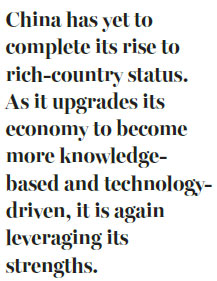Efforts required to leverage city-led growth

Over the past decade, China has been working to shift from a manufacturing-led growth model, fueled by low-cost labor, to an innovation-led, higher value-added model underpinned by strong productivity gains. Urbanization is critical to facilitate this shift, not least by enabling economies of scale.
Currently, although China is the world's most populous country and its second-largest economy, the country's urbanization rate remains well below the global average. Only half its population lives in urban areas, and less than 10 percent are permanent residents in its megacities.
It is China's megacities where the greatest potential to fuel future progress in productivity - and thus GDP growth - is to be found. So far, China has four "first-tier" cities: Beijing, Shanghai, Guangzhou and Shenzhen.
Given the size of China's population and economy, that is not a lot. And, in fact, there is no reason to believe that these megacities have reached their capacity, in terms of population or contribution to economic growth. Moreover, China has many dynamic second-tier cities - such as Chengdu, Tianjin, Hangzhou, Wuhan, and Suzhou - that are capable of reaching first-tier status, if given the chance.
But in order to maximize the potential of China's cities, the government will have to be much more adaptive and flexible, especially regarding its strict control of urban land-development ratios. Otherwise, urbanization will continue pushing up already high housing costs, but not efficiently enough to power sustained development.
The good news is that local governments are already working to alleviate, or even eliminate, existing administrative constraints.
Local governments are now introducing so-called county-district conversions, in order to expand urban districts into rural jurisdictions. Such efforts may enable more housing construction and industrial and commercial expansion.

Another effective strategy for advancing China's transition toward a city-led growth model is to expand the role played by urban clusters that leverage the strength of first-tier cities to boost growth in less-developed areas. From an economic standpoint, the Yangtze and Pearl River Deltas are undoubtedly the most important areas in this regard.
In March, Premier Li Keqiang announced a plan for the development of a city cluster in the Guangdong-Hong Kong-Macau Greater Bay Area that covers nine cities, including Guangzhou and Shenzhen, as well as the special administrative regions of Hong Kong and Macao.
From 2010 to 2016, the annual GDP of the Greater Bay Area soared from 5.42 trillion yuan ($820 billion; 696 billion euros; £619 billion) to 9.35 trillion yuan, making it the world's third-largest urban economy, after Tokyo and New York. Yet the population of the Guangdong-Hong Kong-Macao Greater Bay Area is growing fast, and its GDP per capita is less than half that of Tokyo, suggesting that its potential is nowhere near depleted.
Moreover, China's leaders seem to be eyeing a second Greater Bay area, centered on Hangzhou Bay, which, because it overlaps with the Yangtze River Delta, could go a long way toward integrating that already prosperous region. Such a cluster could cover the coastal megacity of Shanghai, as well as about 10 more important cities in neighboring Zhejiang and Jiangsu provinces. It would include world-class ports, such as the Port of Ningbo-Zhoushan (the world's busiest in terms of cargo tonnage), and it would cover two of China's 11 free-trade zones.
The pace of China's economic growth over the past four decades has been unprecedented. But China has yet to complete its rise to rich-country status. As it upgrades its economy to become more knowledge-based and technology-driven, it is again leveraging its strengths. There is no better example of this than the ongoing effort to tap the potential of megacities.
The author is professor of economics and director of the China Center for Economic Studies at Fudan University. The views do not necessarily reflect those of China Daily.
(China Daily Africa Weekly 10/20/2017 page11)
Today's Top News
- EU has much to learn from China-Global South ties
- Xi holds phone conversation with Merz
- Xi stresses high-quality cultural-ethical advancement
- Trump halts Harvard's intl student enrollment
- Xi's visit gives impetus to our work
- Financing support enhanced for micro, small companies






























